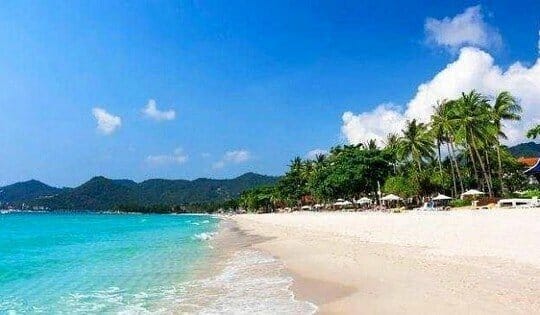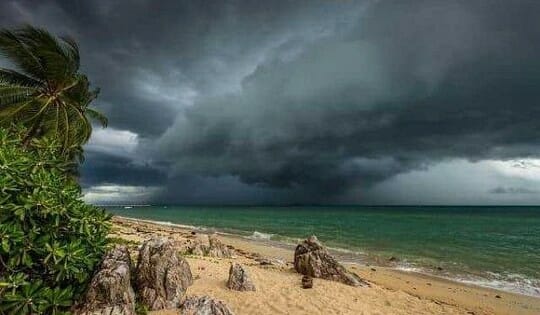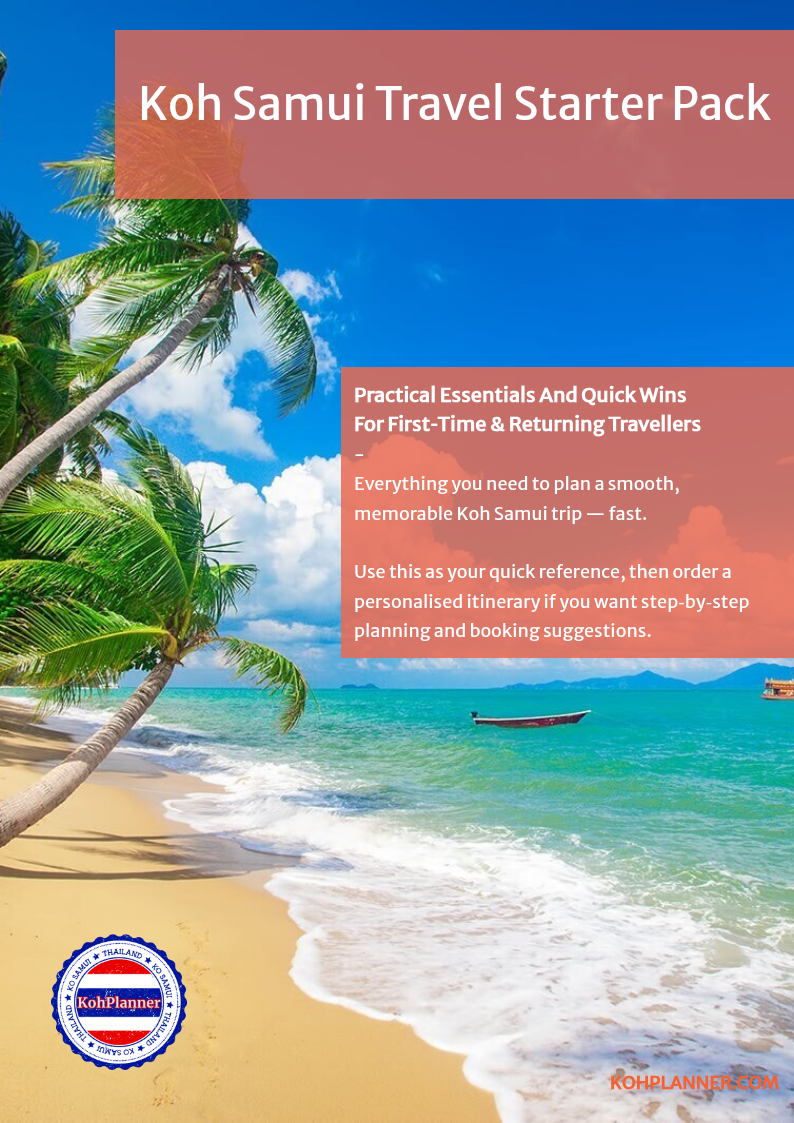Koh Samui Weather
Climate and Best Time to Visit Koh Samui
All about weather in Koh Samui
Welcome to our comprehensive guide about Koh Samui weather! If you’re planning a trip to this tropical paradise, knowing the island’s weather patterns can make a huge difference in your travel experience. From its warm, sunny days to its tropical showers, the weather in Koh Samui is as varied as its stunning landscapes.
Koh Samui can suit a sun worshipper seeking the hot and dry months or a budget traveller looking to take advantage of off-peak deals, our guide will help you understand what to expect from Koh Samui weather throughout the year. From the island’s monsoon season to its sunniest times, we will provide information to help you plan your trip according to the climate and activities you prefer.
Discover the best time to engage in water sports, when to find the quietest beaches, what weather to expect in different areas of the island and when you can expect the most advantageous hotel rates. Your perfect Koh Samui holiday starts with understanding the island’s weather, so pack your shorts, don’t forget the umbrella just in case and let’s dive in!
Koh Samui Geography
Koh Samui, Thailand’s second-largest island, is located in the Gulf of Thailand, off the east coast of the Kra Isthmus. It’s part of the Chumphon Archipelago, which includes over 80 islands, many of which form part of the Ang Thong National Marine Park.
The island’s geographical location, nestled in the Gulf of Thailand, means it is largely protected from the Pacific Ocean’s major weather systems. However, its tropical setting close to the equator results in a warm climate year-round, with temperatures rarely dipping below 25°C.
Here’s how Koh Samui’s geography and placement affect its weather:
- Ocean Placement: The island’s location in the Gulf of Thailand significantly influences its weather. The surrounding warm waters ensure consistent temperatures throughout the year. However, the island’s weather is subject to monsoonal winds, which bring heavy rainfall during the monsoon season (typically from October to early December).
- Mountainous Terrain: The island’s interior is largely mountainous and covered in tropical jungle, with the highest peak, Khao Pom, rising to 635m. These mountains can affect local weather conditions, often trapping clouds to create more rainfall in certain areas.
- Coastal Areas: The coastal areas experience slightly different weather due to sea breezes. During the day, land heats up faster than the ocean, causing air to rise and form clouds, potentially leading to afternoon or evening showers. At night, the process is reversed, often resulting in clearer skies.
- North vs South: The northern and northeastern parts of the island are somewhat protected by the island’s topography and tend to receive less rainfall. The southern part of the island, being more exposed, can experience slightly more rainfall and wind.
Weather in Koh Samui by Areas
Koh Samui’s tropical climate ensures warm temperatures throughout the year, but the island’s diverse geography can lead to slight variations in weather across different parts of the island.
- North and North-Eastern Koh Samui (Bophut, Maenam, Choeng Mon, Plai Laem): These areas often receive less rainfall than the rest of the island, especially in the rainy season. The beaches are protected by the island’s topography, making the sea calmer and more suitable for swimming and other water activities.
- Eastern Koh Samui (Chaweng, Lamai): These areas are known for their beautiful beaches (Chaweng Beach is the most popular) and vibrant nightlife. In terms of weather, they experience similar patterns to the North and North-Eastern regions, however, they may receive slightly more rain during the wet season.
- South and South-Western Koh Samui (Taling Ngam, Lipa Noi): These parts of the island are more isolated and less developed, offering a more peaceful and natural environment. Weather-wise, these areas can receive more rainfall due to their exposure to the open sea. However, this also results in spectacular sunsets and more dramatic landscapes.
- Central Koh Samui (Nathon): This area is mainly mountainous and covered with lush vegetation. The weather here can be slightly cooler than the coastal areas, especially at higher altitudes. Rainfall can also be higher due to the mountainous terrain.
While these are general patterns, the weather in Koh Samui can be unpredictable, and variations can occur. Regardless of the region, the island maintains a warm tropical climate year-round.
Beach or Hill?…
Koh Samui’s weather varies slightly depending on whether you are at ground level, near the beaches, or in the higher areas in the hills and mountains, due to the island’s orographic features. Each may appeal to different types of visitors due to their unique weather characteristics.
- Ground Level/Beaches: The lower, coastal areas of Koh Samui are generally warm throughout the year, with temperatures ranging from 25°C to 35°C. The coastal areas also enjoy a nice breeze from the Gulf of Thailand, which can help moderate the heat, particularly during the hot season from March to May. Rainfall is usually less in these areas compared to the higher regions, but during the monsoon season, these areas can still experience heavy, albeit short-lived, bursts of rain. Perfect for beach lovers, sun worshippers, and water sports enthusiasts. The coastal climate, with its less frequent rainfall, is ideal for those seeking sun-soaked days by the sea, whether for swimming, snorkelling, or simply relaxing on the beach.
- Hills and Mountains: The higher orographic areas of Koh Samui, such as the hills and mountains, can be slightly cooler, especially at night. Due to the increased altitude, these areas can also receive more rainfall as the ascending moist air from the sea cools down and condenses to form clouds. During the rainy season, the higher regions can experience more persistent and occasionally heavier rain. However, these areas offer stunning views of the island, particularly on clear days, and are rich in lush, green vegetation. The cool and green areas of Koh Samui’s hills are perfect for nature lovers and hikers who want to escape the busy beach areas and enjoy a peaceful atmosphere. With their slightly cooler temperatures and increased rainfall, these areas offer lush, green landscapes and stunning panoramic views of the island. These are the places to immerse yourself in nature, enjoy bird-watching, explore waterfalls, or engage in meditation and yoga retreats.
Gulf of Thailand Weather
vs
Andaman Sea Weather
Same, Same?… not really!
Geography & Orography
- Gulf of Thailand (Koh Samui, Koh Phangan, Koh Tao): Positioned on Thailand’s east coast, the Gulf of Thailand is partly enclosed by the mainland and surrounding islands, which moderates the sea’s weather conditions. The region’s geography and the sea’s shallow depth contribute to warmer sea temperatures, leading to higher humidity levels and a different monsoon schedule compared to the Andaman Sea.
- Andaman Sea (Phuket, Krabi, Koh Lanta): Located on the west coast of Thailand and part of the Eastern Indian Ocean, the Andaman Sea is influenced by the Indian Ocean Dipole and the Southwest Monsoon, resulting in a different pattern of weather events. Its deeper waters lead to cooler sea temperatures, affecting the surrounding climate.
Weather, Temperatures, and Precipitations
- Gulf of Thailand: This region’s climate is warm throughout the year, with temperatures ranging from 25°C to 35°C. The rainy season typically falls between September and December, and the area experiences its driest period from January to April. The Gulf’s warmer water temperatures often result in higher humidity levels, particularly during the hot season.
- Andaman Sea: The Andaman Sea area also enjoys warm temperatures year-round, averaging between 23°C to 32°C. However, its monsoon season generally occurs from May to October, a different pattern from the Gulf of Thailand. Despite this, the Andaman Sea region tends to have cooler sea temperatures, leading to a slightly less humid climate.
Best Months & Areas to Visit
Again, “best” is a term that when travelling can associate with “busy”. Consider your own preferences to match your holiday style.
- Gulf of Thailand: The best time to visit the Gulf of Thailand, particularly for beach activities and water sports, is during the dry season (January to April). However, for those looking to avoid crowds and enjoy lower rates, the rainy season (September to December) can be an attractive option. The North and North-Eastern areas of Koh Samui (Bophut, Maenam, Choeng Mon, Plai Laem) are often less rainy and offer calmer sea conditions, making them ideal for swimming and other water activities.
- Andaman Sea: The prime time to visit the Andaman Sea region is during its dry season (November to April), which is perfect for beach holidays, snorkelling, diving, and exploring the stunning marine life. The rainy season (May to October) is typically quieter and offers better accommodation deals. For diving enthusiasts, the Similan Islands and Surin Islands in Phuket are excellent during the dry season.
Tips For Choosing
- Gulf of Thailand: Keep in mind that while the Gulf’s weather is generally warm and sunny, it’s also prone to sudden, heavy showers. Consider packing light, breathable clothing and a light raincoat or umbrella.
- Andaman Sea: The Andaman coast can experience rough seas during the monsoon season, so be aware if planning boat trips or water activities during this period. Always stay updated with the local weather forecast.
- The best time to visit either the Gulf of Thailand or the Andaman Sea depends largely on your preferences and planned activities. Whether you’re seeking sunny beach days, quieter off-peak travel, or adventurous water sports, both regions offer unique experiences framed by their distinctive climates.
Check the graphs below comparing rainfall precipitation in different popular destinations in Thailand to compare, including Chiang Mai, Phuket and Bangkok. The data is provided by the Thai Meteorological Department (2018).
Koh Samui Weather by Season
Koh Samui is a tropical island with pleasant temperatures all year round. Rain can be unpredictable and, at times, torrential. There are 3 seasons in Koh Samui as in the rest of Thailand: Dry, Hot and Rainy, also known as Cool, Hot and Wet.

DRY SEASON
Mid-December to February
The Dry Season in Koh Samui spans from mid – late December to February. These months are characterized by pleasant weather, with minimal rainfall and ample sunshine. The average temperature hovers around a comfortable 27°C to 29°C. This is the time when the island showcases its tropical beauty in full glory, with clear blue skies, calm sea waters, and verdant landscapes.
What to Expect
During the Dry Season, the island enjoys long, sunny days, perfect for exploring its numerous attractions or just lounging on its stunning beaches. The sea is calm and inviting, making it an excellent time for water sports like swimming, snorkeling, and diving.
The weather is generally mild during the day, with temperatures that are warm but not uncomfortable, thanks to the gentle sea breezes. The evenings are cooler, creating the perfect setting for beachside dinners or moonlit walks.
The lack of rain during this period means that the island’s roads are dry and safe, making it easier to explore the island, whether you choose to rent a motorbike or prefer a car.
Tips for Travelers
Accommodation: The Dry Season is the high season in Ko Samui, which means the island can get crowded, and hotel prices can be higher than usual. It’s advisable to book your accommodation well in advance to secure a good deal and avoid last-minute hassles.
Packing: Pack light, breathable clothes for the day. Don’t forget your swimwear, as you’ll want to make the most of the beach and the sea. Carry a light sweater or wrap for cooler evenings. Sunscreen, sunglasses, and a hat are a must to protect yourself from the sun.
Activities: This is the best time to indulge in water sports and boat tours. Plan for a trip to the Ang Thong National Marine Park or a diving excursion to Sail Rock. Also, explore the local markets and food scene.
Festivities: This season also includes some interesting festivities, such as New Year’s celebrations and Chinese New Year. Participating in these local festivities can add a unique flavor to your holiday.
Stay Hydrated: The days can get warm, so keep yourself hydrated. Always carry a bottle of water when you’re out exploring.
The Dry Season in Koh Samui is a wonderful time to experience the island’s stunning beauty and vibrant culture. With the right planning and preparation, you’re all set for an unforgettable tropical holiday!

HOT SEASON
March to August
The Hot Season in Koh Samui extends from March to August. These months are characterized by intense heat and high humidity, with occasional thunderstorms. The average temperature can get over 30°C. Despite the heat, the island remains vibrant and lively, with lush greenery and warm crystal-clear ocean waters.
What to Expect
During the Hot Season, the island basks in the tropical sun, creating ideal conditions for sunbathing and enjoying the stunning beaches. The sea remains warm and inviting, perfect for swimming, snorkeling, and diving.
The weather is generally hot during the day, with temperatures soaring above 30°C. However, the cool sea breezes offer a respite from the heat. The evenings are slightly cooler, offering a pleasant atmosphere to enjoy the island’s vibrant nightlife.
Despite the high heat, the season also experiences intermittent rain showers, often followed by beautiful rainbows. These short, refreshing showers bring a welcome relief from the heat.
Tips for Travelers
Accommodation: Despite the heat, the Hot Season sees a fair share of tourists, especially during the Songkran Festival (April) and school holidays (July and August). Consider booking your accommodation in advance to secure a good deal.
Packing: Pack lightweight, breathable clothes for the day, preferably in natural fabrics like cotton or linen. Don’t forget your swimwear, sun hat, sunglasses, and a high-SPF sunscreen to protect yourself from the strong tropical sun.
Activities: Water sports are a great way to beat the heat. Plan for activities like paddleboarding, jet-skiing, or even a refreshing dive. Make an early morning trip to the local markets to skip the midday heat and sample the local food scene.
Hydration: The high heat and humidity can lead to dehydration. Carry a water bottle, and drink plenty of fluids throughout the day.
Sightseeing: Plan your sightseeing activities for early morning or late afternoon to avoid the peak heat hours.
Festivities: The Hot Season includes the Thai New Year or Songkran (Mid-April), characterized by water fights across the country. Participating in these festivities can be an exciting experience.
The Hot Season in Koh Samui allows you to immerse in the tropical ambiance of the island. With the right preparation and precautions, you’re in for an exciting and vibrant holiday experience!

WET SEASON
September to Mid-December
The Wet Season in Koh Samui runs from September to mid-December. This season is marked by regular rain showers and occasional thunderstorms. The average temperature during this period ranges from 23°C to 30°C. Despite the rains, the island retains its alluring beauty, with verdant landscapes and a serene atmosphere.
What to Expect
During the Wet Season, the island experiences frequent showers, often heavy but usually short-lived. The rain enhances the island’s beauty, washing everything clean and causing the vegetation to flourish. The sea can be rough at times, and the sky is often overcast.
The weather is cooler compared to the hot season, offering a respite from the heat. The rain showers are interspersed with periods of sunshine, creating a pleasant climate. The evenings are cool and refreshing, making this an ideal time for relaxing indoor activities.
Despite being the monsoon season, this period offers an opportunity to experience the island’s natural beauty in a less crowded setting. The rain also provides a unique ambiance for activities like yoga classes, wellness retreats, and exploring the island’s vibrant dining scene.
Tips for Travelers
Accommodation: The Wet Season is considered off-peak, which means fewer tourists and lower accommodation rates. This is an excellent opportunity to bag some great deals on hotels and resorts.
Packing: Pack lightweight, breathable clothes that dry quickly. Don’t forget to pack a waterproof jacket or umbrella and water-resistant shoes for the rain showers.
Activities: Indoor activities like spa treatments, cooking classes, and yoga are popular during this season. This is also a great time to explore the local markets, restaurants, and indoor attractions.
Travel Safely: Road conditions can be slippery during the rains. If you’re planning to rent a vehicle, drive slowly and cautiously.
Floods: Be aware of potential flooding in some areas after heavy rainfall. Keep an eye on local weather updates and plan your activities accordingly.
Health: The rain can lead to an increase in mosquitoes. Carry an effective insect repellent to avoid mosquito-borne diseases.
The Wet Season in Koh Samui allows you to experience the island’s quieter side and offers unique experiences. With the right preparation and a flexible attitude, you’re set for a serene and rejuvenating holiday!
Best Time to Visit Koh Samui
The best time to visit Koh Samui is different for everyone, and it depends on what is more important to you: warm weather and plenty of sunshine, no rain, great prices and offers, avoiding crowds.
November is the wettest month of the year with rainfall on most days. Some holidaymakers, looking to relax, choose this time of year to come and enjoy activities like yoga classes, Muay Thai classes, wellness and fitness retreats. You can take advantage of the quiet beaches and hotel’s lower rates. However, if you are coming from a country with cold or rainy conditions, looking for sun and water sports, probably better to skip the rainy season and visit from mid-December to August.
As we mentioned above, the best time to visit the island depends on your own preferences. If a beach holiday is what you’re after, aim for the hot and dry seasons. If you are into kite surfing, there are some good spots with decent wind speed in Nathon, where you can surf during the quieter months. If you prefer to enjoy a retreat, any time is good. If you are tight on budget, perhaps the low season can be more appealing to your needs.
The best thing about Koh Samui is that you have so many options to choose from, whether you are looking for a beach day, adventure, water sports, exploring, eating or relaxing.
At anytime during the year, including the monsoon season, the average temperature ranges from 28 °C to 30 °C. At night, it might be cooler if there is wind or a little rain, but the daytime temperature is mostly pleasant. Sometimes, in the hot season, rainy days are a blessing!
What to Expect
Any time is great to visit the island, apart from November, the rainiest month of the year. But as Thais say, in Thailand you get 3 seasons: “Hot – Hotter – Hottest”. Most of the year you should expect sunny days, calm seas, nice water temperature, high humidity, and the occasional tropical thunderstorm. February is usually the driest month right in the peak season.
Unpredictable
The weather can be difficult to predict. Clouds move fast and there are microclimates in different locations on the island. Even popular weather forecast sites don’t get it right. You may see a forecast showing tropical storms every day, but then, not see a single rain shower in the whole week. Go with the historical averages on this page to get an idea and check the forecast for guidance.
Health
During floods, be aware of health risks and hazards. Please use common sense, when choosing your activities. Floods carry sewage waters, bacteria and debris, so it’s important to avoid skin contact. You can get cut or develop a serious infection. As well, beware of mosquitos after the rain!


